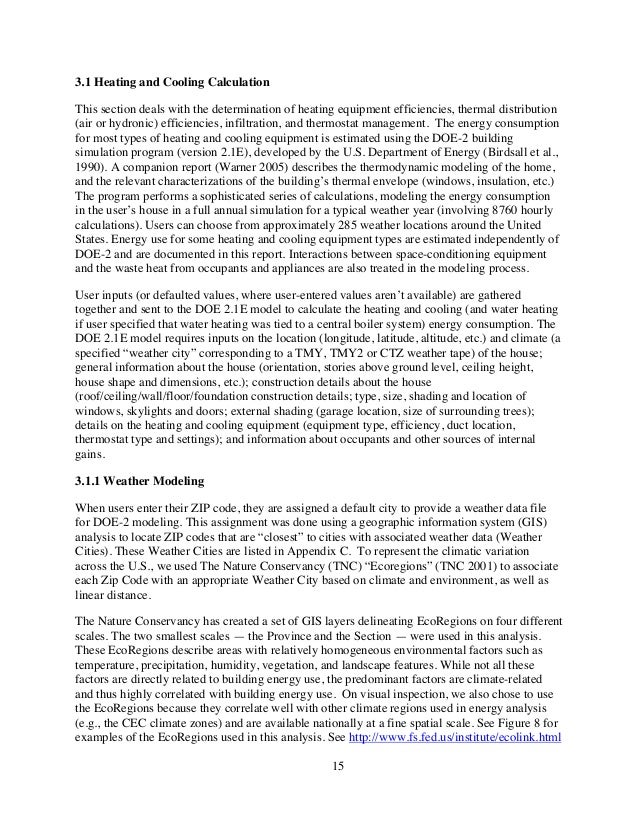This report documents many of the validation studies (Table 1) of the DOE-2 building energy analysis simulation program that have taken place since 1981. Results for several versions of the program are presented with the most recent study conducted in 1996 on version DOE-2.1E and the most distant study conducted in 1981 on version DOE-1.3. DOE-2 supplement: Version 2.1E. Article November 1993. The room air temperature and relative humidity were calculated with the building energy simulation program DOE-2.1E. The materials. Program Name or Ancillary Text eere.energy.gov EnergyPlus: DOE’s Next Generation Simulation Program. Crawley, Ph.D. Department of Energy. Energy Efficiency and Renewable Energy. Building Technologies Program. February 16, 2010.
Abstract
The most recent version of the DOE-2 building energy simulation program, DOE-2.1E, provides for more detailed modeling of the thermal and optical properties of windows. The window calculations account for the temperature effects on U -value, and update the incident angle correlations for the solar heat gain properties and visible transmittance. Initial studies show up to a 35% difference in calculating peak solar heat gain between the detailed approach and a constant shading-coefficient approach. The modeling approach is adapted from Lawrence Berkeley Laboratory's WINDOW 4 computer program, which is used in the National Fenestration Rating Council (NFRC) U -value rating procedure 100-91. This gives DOE-2.1E the capability to assess the annual and peak energy performance of windows consistent with the NFRC procedure. The program has an extensive window library and algorithms for simulating switchable glazings. The program also accounts for the influence of framing elements on the heat transfer and solar heat gain through the window.
Journal
Energy and Buildings – Elsevier
Published: Mar 1, 1995
Who
People and organizations associated with either the creation of this article or its content.
What
Descriptive information to help identify this article. Follow the links below to find similar items on the Digital Library.
- Metadata API:descriptive and downloadable metadata available in other formats
When
Dates and time periods associated with this article.
Interact With This Article

Here are some suggestions for what to do next.
Circuit Simulation Program
We support the IIIF Presentation API
Links for Robots
Helpful links in machine-readable formats.
Problem Solving Software
- ERC Record: /ark:/67531/metadc692098/?
- Persistence Statement: /ark:/67531/metadc692098/??
- IIIF Manifest: /ark:/67531/metadc692098/manifest/
- UNTL Format: /ark:/67531/metadc692098/metadata.untl.xml
- DC RDF: /ark:/67531/metadc692098/metadata.dc.rdf
- DC XML: /ark:/67531/metadc692098/metadata.dc.xml
- OAI_DC: /oai/?verb=GetRecord&metadataPrefix=oai_dc&identifier=info:ark/67531/metadc692098
- METS: /ark:/67531/metadc692098/metadata.mets.xml
- OpenSearch Document: /ark:/67531/metadc692098/opensearch.xml
- Thumbnail: /ark:/67531/metadc692098/thumbnail/
- Small Image: /ark:/67531/metadc692098/small/
- In-text: /ark:/67531/metadc692098/urls.txt
- Usage Stats: /stats/stats.json?ark=ark:/67531/metadc692098
Simulation
A Preliminary Evaluation of the DOE-2.1E Ground Vertical Well Model Using Maxey School Measured Data,article, June 19, 1999; Oak Ridge, Tennessee. (https://digital.library.unt.edu/ark:/67531/metadc692098/:accessed August 29, 2019),University of North Texas Libraries, Digital Library, https://digital.library.unt.edu; crediting UNT Libraries Government Documents Department.